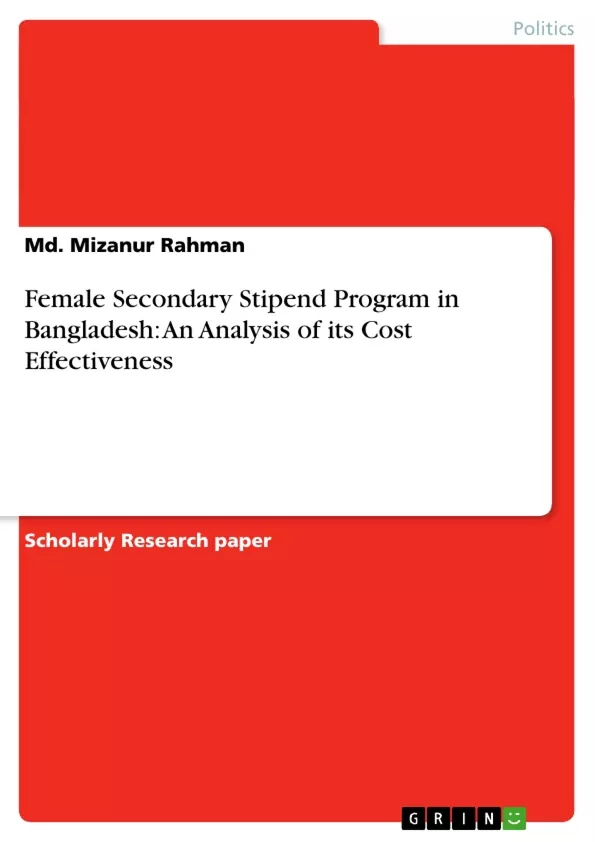Bangladesh as one of the South Asian countries has been striving to develop a comprehensive
education policy since its independence but failed to formulate such policy that could contribute to the
development of the economy. The basic problem of primary and secondary level is poor enrolment
and low retention rate in the school. To combat with this problem government of Bangladesh has been
undertaking myriad policies and programs. Among such policies Female Secondary Stipend Program
(FSSP), Food For Education Program (FFEP) and Free Text Book Distribution Program to the
students of primary and secondary level are some innovative and better contributing policy
interventions in the field of female education in Bangladesh. All these policy interventions are
purported with the pivotal motto of reducing drop rate and increasing enrollment rate in the secondary
education. All these policies are currently in operation except the Food for Education Program which
has transformed into a cash transfer program very recently. Based on the policy problem of reducing
dropout rate of the secondary female students in the school, the above policies on FFEP, FTBDP and
FSSP were chosen as three policy alternatives taking FSSP as status quo with a view to measuring
efficacy of these policies employing the cost effectiveness analysis method apprising their relative
worth in reducing dropout of female students in the secondary level calculating the base year 1994 and
analyzing up to 2015 years data and thereafter to suggest the best policy option for the government of
Bangladesh. Data were generated and gathered from the available literatures on the above-mentioned
alternatives. Primarily FSSP populations were used as baseline population and compare it with
dropout and enrolment rate achieved of all the relevant alternatives and based on the unit cost and
retained student CEA of all the policy alternatives were calculated on excel sheets first and all data
were manually transformed into word format. The findings of the policy analysis unearthed the fact
that in considering CEA of all the policy alternatives it was found that by using $1 it is possible to
achieve a non-drop out sustained of 219 females in case of status quo (FSSP). In case of FTBDP by
using 1$ it will be possible to retain 970 female students. In relation to FFEP it will cost the same $1
to achieve a non-drop out sustained of 14371 females enrolled. [...]
Inhaltsverzeichnis (Table of Contents)
- Introduction
- A Brief Overview of Educational System in Bangladesh
- The Status of Primary and Secondary in Education in Bangladesh
Zielsetzung und Themenschwerpunkte (Objectives and Key Themes)
This policy analysis aims to assess the cost-effectiveness of the Female Secondary Stipend Program (FSSP) in Bangladesh, comparing it to two other interventions: the Food for Education Program (FFEP) and the Free Text Book Distribution Program (FTBDP). The analysis seeks to determine the most efficient policy option for the government to maximize female student retention and enrollment in secondary education.
- Cost-effectiveness analysis of educational policy interventions in Bangladesh
- Impact of FSSP, FFEP, and FTBDP on female student dropout rates and enrollment rates
- Comparison of the relative worth of different policies in reducing dropout rates
- Evaluation of the efficacy of education transfer programs in Bangladesh
- Importance of gender parity in education and its contribution to national development
Zusammenfassung der Kapitel (Chapter Summaries)
The first chapter provides a comprehensive overview of the educational system in Bangladesh, outlining the structure of primary, secondary, and tertiary education. It highlights the government's commitment to promoting education for all, particularly for female students. The chapter presents data on enrollment rates and dropout rates in primary and secondary education, emphasizing the challenges faced by the education system in Bangladesh.
Schlüsselwörter (Keywords)
Cost-effectiveness analysis, Female Secondary Stipend Program (FSSP), Food for Education Program (FFEP), Free Text Book Distribution Program (FTBDP), education policy interventions, female education, dropout rates, enrollment rates, gender parity, education system, Bangladesh.
- Arbeit zitieren
- Md. Mizanur Rahman (Autor:in), 2013, Female Secondary Stipend Program in Bangladesh: An Analysis of its Cost Effectiveness, München, GRIN Verlag, https://www.grin.com/document/210422



